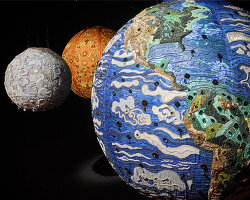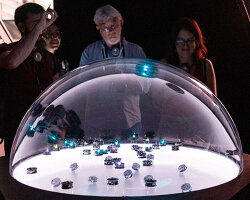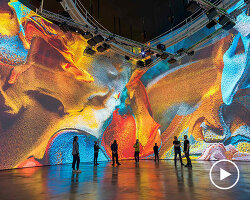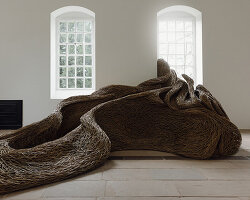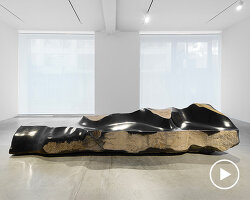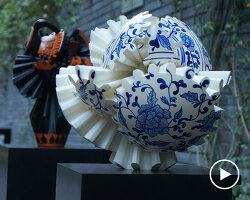the impossible statue units five iconic sculptors through ai
What if you could resurrect the artistic legacy of five renowned sculptors who lived 500 years apart using AI? Recently unveiled by the Swedish engineering team at Sandvik, the Impossible Statue represents a remarkable fusion of art and technology. Showcased at Tekniska Museet, Sweden’s National Museum of Science and Technology, this modern engineering masterpiece harnesses the collective styles of five legendary sculptors, Michelangelo, Rodin, Kollwitz, Kotaro, and Savage. Spanning continents and centuries, these visionary masters converge in a captivating stainless steel sculpture, bridging 500 years of sculpting into one modern piece.
Weighing 500 kg and towering at 150 cm, the statue is the result of cutting-edge AI technology, advanced software solutions, and meticulous craftsmanship. By seamlessly integrating Artificial Intelligence and engineering, the team at Sandvik has breathed new life into the timeless artistry of these extraordinary artists.‘Through the harmonious integration of Artificial Intelligence and engineering, we have successfully resurrected some of the greatest artists from bygone eras, breathing new life into their timeless artistry.’
![]()
all images by Sandvik
bringing 500 years of sculpting into one modern statue
Utilizing the power of AI modeling and employing state-of-the-art manufacturing solutions, the Impossible Statue has emerged as a testament to human ingenuity. Crafted from stainless steel, the sculpture pushed the boundaries of complexity and precision, putting ‘Sandvik’s advanced digital manufacturing solutions and cutting tools to the test’.
According to the team, The Impossible Statue stands as a shining example of the incredible possibilities that arise when modern technology converges with human brilliance. ‘Our mission is to create a broader understanding of the possibilities of technology and to stimulate the next generation to pursue a career within STEM-topics. This project is ticking all the boxes for us and I’m excited to offer our visitors the opportunity to see the statue,’ said Peter Skogh, Director at Tekniska Museet (see more here).
![]()
the statue weights 500 kg and spans a height of 150 cm
Resurrecting five artistic legends
The statue combines the artistic elements of renowned sculptors from different countries and eras. Each sculptor’s unique style and characteristic elements were carefully studied and incorporated into the design. The statue captures Michelangelo’s dynamic poses, lending a sense of life and vitality to the final piece. The musculature and reflectiveness, characteristic of Auguste Rodin’s sculptures, were also incorporated. Moreover, elements of Kollwitz’s expressionism, Takamura’s emphasis on momentum and mass, and Savage’s defiance were also infused into the resulting structure.
After combining the artistic styles of these five artists into a 2D design, Sandvik embarked on a process to transform it into a complete 3D image. Employing depth estimators, an initial 3D model was constructed, while human pose-estimators were utilized to enhance the body’s form. Videogame algorithms were used to generate lifelike fabric, and specialized AI was employed to restore intricate details that may have been lost in earlier stages. Utilizing Mastercam, the industry’s leading CAM (computer-aided manufacturing) software, a statue with over 9 million polygons and intricate complexities was successfully crafted.
![]()
the impossible statue is created with over 9 million polygons and intricate complexities
The manufacturing process underwent meticulous testing through simulations prior to any physical material being utilized. Sandvik Coromant, utilizing their proprietary machining simulation and optimization software called Vericut, ensured that the tooling and machining processes were executed with utmost safety, reliability, and efficiency. Thanks to the digital perfection achieved before the commencement of machining, not a single part of the statue required scrapping and remaking, attesting to the precision and effectiveness of the digital workflow.
Sandvik opted to machine 17 separate pieces using a wide range of Sandvik Coromant tools for turning, milling and drilling. This approach was deemed superior to alternative methods primarily because it resulted in enhanced surface quality. The exceptional precision achieved in the final craftsmanship rendered the intersections between the various parts nearly imperceptible to the naked eye. By dividing the statue into sections, the team effectively minimized the quantity of steel needed. Moreover, any excess material removed from the original stainless steel pieces was recycled through Alleima, Sandvik’s materials supplier for the project.
![]()
thanks to the digital perfection, there was no need to scrap or remake any part of the statue
![]()
by dividing the statue into sections, the team effectively minimized the quantity of steel needed
project info:
name: The Impossible Statue
developer: Sandvik | @sandvikgroup
exhibited at: Tekniska Museet (Sweden’s National Museum of Science and Technology) | @tekniskamuseet


